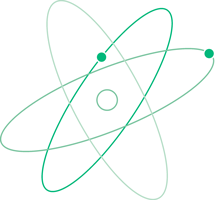Electromagnetic field energy balance for dispersive medium
DOI:
https://doi.org/10.3103/S0735272720100052Keywords:
dispersive medium, accumulated energy, dissipation energyAbstract
In this paper electromagnetic field energy balance equation for linear homogeneous dispersive stationary medium is deduced in general form. No dispersive limitations on ε′, ε", μ′, and μ" are used. Thus the following question is answered: why do existing equations not provide correct values for accumulated energy and dissipated energy in dispersive media? An electromagnetic field energy balance equation for harmonic processes is obtained. This equation separates into active energy and reactive energy equations. Each of these equations contains four terms. For active energy equation the first two terms determine dissipation energy per unit volume. Each of these two terms can be expressed as a sum of three terms: the first one determines dissipation energy for unit volume without dispersion; the other two terms describe dissipation energy density due to dispersion. The third term is a Poynting vector real part change rate for frequency and coordinate, the last term—determines external source active energy density. The first two terms for reactive energy determine electromagnetic field accumulated energy density per unit volume. Each of these two terms of electromagnetic field accumulated energy density can be expressed as a sum of three terms: the first one determines accumulated energy for unit volume without dispersion; the other two terms are accumulated energy additions due to dispersion. The third term is a Poynting vector imaginary part change rate for frequency and coordinate. The last term—determines external source reactive energy density. Presented electromagnetic field energy characteristics definitions satisfy the second law of thermodynamics.References
A. D. Yaghjian, “Classical power and energy relations for macroscopic dipolar continua derived from the microscopic maxwell equations,” Prog. Electromagn. Res. B, vol. 71, no. 1, pp. 1–37, 2016, doi: https://doi.org/10.2528/PIERB16081901.
M. Gustafsson, C. Ehrenborg, “State-space models and stored electromagnetic energy for antennas in dispersive and heterogeneous media,” Radio Sci., vol. 52, no. 11, pp. 1325–1343, 2017, doi: https://doi.org/10.1002/2017RS006281.
G. Kaiser, “Conservation of reactive em energy in reactive time,” in 2015 IEEE International Symposium on Antennas and Propagation & USNC/URSI National Radio Science Meeting, 2015, vol. 2015-Octob, pp. 1704–1705, doi: https://doi.org/10.1109/APS.2015.7305241.
B. L. G. Jonsson, M. Gustafsson, “Stored energies in electric and magnetic current densities for small antennas,” Proc. R. Soc. A Math. Phys. Eng. Sci., vol. 471, no. 2176, p. 20140897, 2015, doi: https://doi.org/10.1098/rspa.2014.0897.
A. D. Yaghjian, “Internal energy, q-energy, poynting’s theorem, and the stress dyadic in dispersive material,” IEEE Trans. Antennas Propag., vol. 55, no. 6, pp. 1495–1505, 2007, doi: https://doi.org/10.1109/TAP.2007.897350.
S. M. Mikki, Y. Antar, “Reactive, localized, and stored energies: the fundamental differences and proposals for new experiments,” in 2015 USNC-URSI Radio Science Meeting (Joint with AP-S Symposium), 2015, pp. 366–366, doi: https://doi.org/10.1109/USNC-URSI.2015.7303650.
D. Nikolayev, M. Zhadobov, P. Karban, R. Sauleau, “Electromagnetic radiation efficiency of body-implanted devices,” Phys. Rev. Appl., vol. 9, no. 2, p. 024033, 2018, doi: https://doi.org/10.1103/PhysRevApplied.9.024033.
M. González, J. Pozuelo, J. Baselga, “Electromagnetic shielding materials in ghz range,” Chem. Rec., vol. 18, no. 7–8, pp. 1000–1009, 2018, doi: https://doi.org/10.1002/tcr.201700066.
D. Sarkar, S. M. Mikki, K. V. Srivastava, Y. M. M. Antar, “Dynamics of antenna reactive energy using time-domain idm method,” IEEE Trans. Antennas Propag., vol. 67, no. 2, pp. 1084–1093, 2019, doi: https://doi.org/10.1109/TAP.2018.2880047.
M. M. Bredov, V. V. Rumiantsev, I. N. Toptygin, Classical Electrodynamics [in Russian]. St. Petersburg: Lan, 2003.
L. D. Landau, P. L. Pitaevskii, E. M. Lifshitz, “Electrodynamics of continuous media,” in Course of Theoretical Physics, 2nd ed., Oxford: Butterworth-Heinemann, 1984, p. 480.
E. J. Rothwell, M. J. Cloud, Electromagnetics. Boca Raton, FL: CRC Press, 2018, doi: https://doi.org/10.1201/9781315222578.
B. Thidé, Electromagnetic Field Theory. Uppsala: Upsilon Books, 2002, uri: https://www.sicyon.com/resources/library/physics/EMFT_Book.pdf.
M. N. O. Sadiku, Numerical Techniques in Electromagnetics, 2nd ed. Boca Raton, New York, London, Washington: CRC Press, 2001, uri: http://inis.jinr.ru/sl/Simulation/Sadiku,_Numerical_Techniques_in_Electromagnetics,2001.pdf.
J. G. Van Bladel, Electromagnetic Fields, 2nd ed. New Jersey: Wiley-IEEE Press, 2007, uri: https://www.wiley.com/en-us/Electromagnetic+Fields%2C+2nd+Edition-p-9780471263883.
L. Novotny, “Lecture notes on electromagnetic fields and waves,” Zurich, 2013. uri: https://www.photonics.ethz.ch/fileadmin/user_upload/Courses/EM_FieldsAndWaves/CompleteNotes.pdf.
L. A. Vainshtein, Electromagnetic Waves [in Russian]. Moscow: Radio i Svyaz’, 1988.


